Football in America: Chicago—Where Traditions Are Born, Revived and Obsessed Over

Welcome to The MMQB’s eight-part series, “Football in America,” in partnership with State Farm. We’ll take the temperature of the game at various levels—youth, high school, college, the NFL and more—in a changing landscape for the sport, in eight locales across the United States. This week: Episode VI—Chicago.
Episode I: The Bay Area
Episode II: Carolina
Episode III: Minnesota
Episode IV: Dallas
Episode V: Arizona
Video: John DePetro
Amid Shrinking Public Programs, One Getting Started
Thursday, 3:45 p.m.
Winnemac Park, North Side
Alan Rood is the kind of coach who doesn’t let anything go. On the sideline he has just one volume level: loud. So when one of his Von Steuben High guards lets a defensive end get past on the inside for an easy lane to the ball carrier, Rood calls the player off the field to correct him immediately. “You have to come downhill!” he says. “If I go downhill, no one can get inside of me! I feel like you’re in P.E. right now and giving half your effort!” Five minutes later Rood walks back over to the same player to provide some more loud feedback on the same mistake. He hasn’t moved on.
“I don’t stop coaching ever,” he says after the game. “You’ve always got to coach, because you’re not helping us if you’re not doing the right things.”
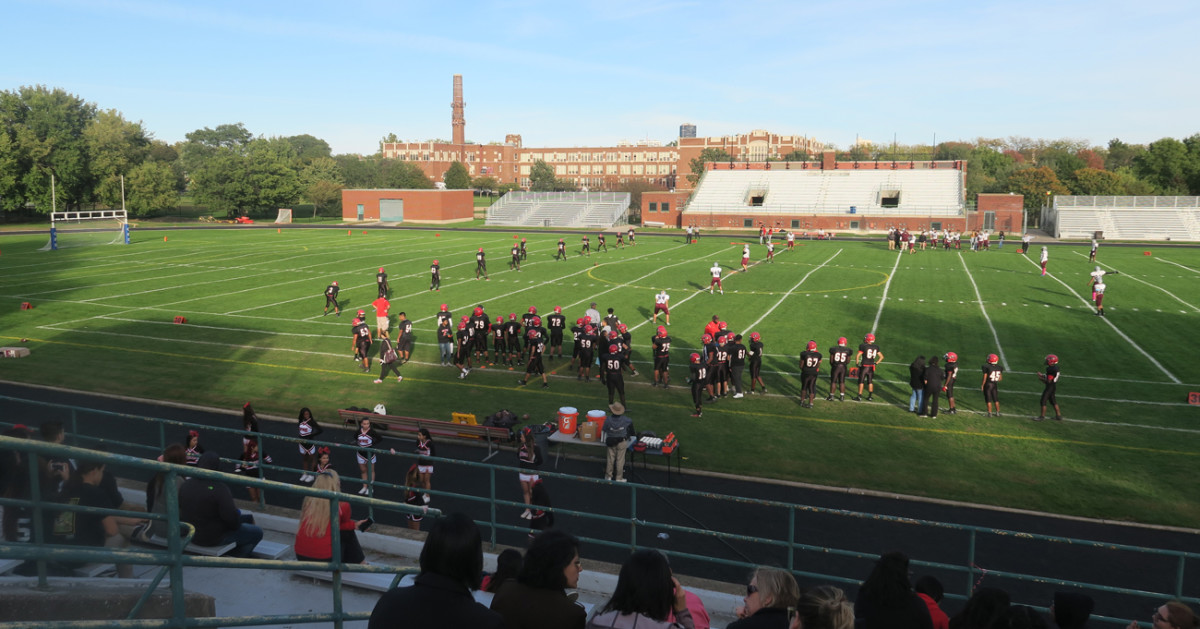
This isn’t your typical high school football coaching gig. Rood started the Von Steuben program from scratch three years ago. For the first 87 years of its existence, Von Steuben, a magnet school on Chicago’s Northwest Side, did not have a football program. Within Chicago Public Schools, basketball is king, and declining football participation and limited resources make it much more common to see news of a football program shuttering rather than starting up. Fifteen of the CPS’s 96 varsity football programs cancelled their 2017 seasons, mainly because of low participation numbers, and a 16th program combined players with another school to save its season. Rood has built program from the ground up—the team now has 54 players—and posted winning seasons in each of its first two years. For a Chicago public school, that’s a remarkable feat.
At the start, Rood’s job more closely resembled a youth football coach. In the first season only two players out of some 50 who signed on had any experience playing organized football. “It was like coaching 8- and 9-year-olds,” he says. “As a football coach, getting guys just understanding plays—that was the hardest challenge.”
Chris Robles was a sophomore that first season, 2015. Before he joined the team his only experience with playing football was of the Madden variety. He loved the sport and dreamed of playing high school ball, but when he saw the promotional posters for the first football info meeting, he hesitated. “I was kind of nervous, to tell you the truth,” says Robles, now a senior defensive end/left tackle. “Should I actually do it? Because this isn’t Madden. I didn’t know what to do during football. I knew positions, like, oh that’s a quarterback, he’s going to throw the ball, but I didn’t know the actual game itself.”
As a first-generation American, senior quarterback Andres Ortiz also had a late introduction to football. His parents immigrated to Chicago from Ecuador in the ‘80s, and knew nothing about the American sport. “I always tried to push him as a little kid to play soccer, and it was strange, he didn’t like it,” says Roque Ortiz, Andres’ father. “Then all of a sudden when he was in middle school, he started to get interested in football, and he came home complaining, Oh, why you didn’t teach me football?”
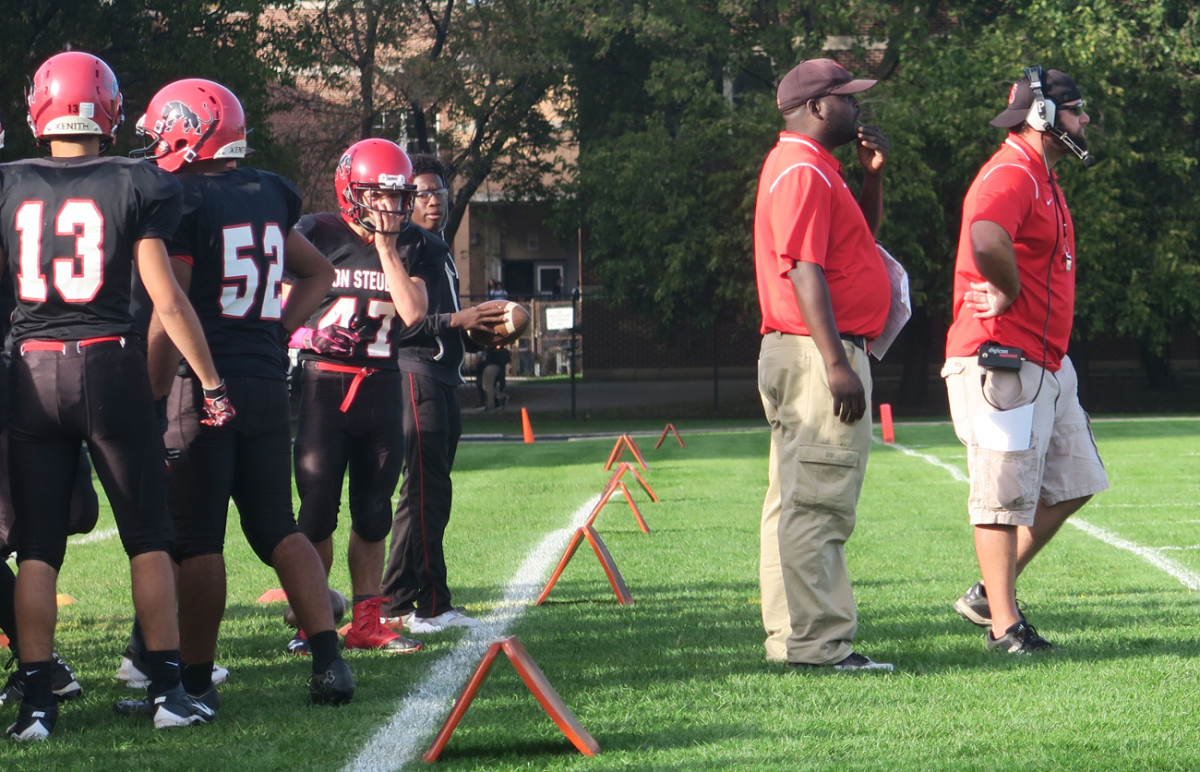
Although he’s just 5’9” and 160 pounds, Ortiz knew he had a good arm, from playing some flag football at recess. He wrote down his position as quarterback at the very first meeting and has been the Panthers’ starter ever since.
Chicago’s magnet schools, which offer specialized subject areas, draw applicants from around the city, with admission based on lottery for those who meet the academic requirements. Von Steuben is known for its engineering program and its focus on math and science. Both Robles and Ortiz want to study mechanical engineering next year in college. They’re currently building a prototype of a new bike lock that functions like a station to park bikes.
The Illinois High School Sports Association eligibility rules state that a student must be passing five classes out of seven to play football. That doesn’t fly with Rood. “We hold them to a higher standard,” he says. “You can’t have an F on our team and play. You can’t have two Ds.”
Like the majority of CPS teams, Von Steuben doesn’t have its own facilities or field. The Panthers practice at nearby Northeastern Illinois University and play home games at Winnemac Stadium, a.k.a. Jorndt Field, a venerable old red-brick venue field that hosts up to five high schools games each week. (That’s actually a bit low for a Chicago public field, but Winnemac doesn’t have lights, and hence the early kickoff.) The playing field itself is uneven—there’s a noticeable hump running down the middle of the field from end zone to end zone,. The grass is pocked with holes and divots. “We have had bad snaps, because the ball has gotten stuck in a hole,” Rood says. At Hanson Stadium, where the team plays a few away games, the surface isn’t much better. “It’s the 1985 Bears AstroTurf, the carpet,” says Rood.
Thought this is just the team’s second varsity season, Rood is actively working to create traditions and rivalries for the players to rally around, such as The Kimball Cup, a helmet that serves as a trophy for the victor of the matchup with neighboring Roosevelt High.
In this afternoon’s game, against North Grand, the Panthers take a 16-6 lead into the half, on the strength of a strong run game and tight defense—Robles registering a safety in the first quarter when he burst through the North Grand line on a pitchout and tackled the runner deep in the end zone. Rather than retreat to the locker room, Von Steuben players remain on the sideline and turn to face the bleachers. It’s the last game of the season, and the seniors are being celebrated. Rood would have preferred a pregame ceremony, but with a 3:45 p.m. kickoff, few parents could have made it.
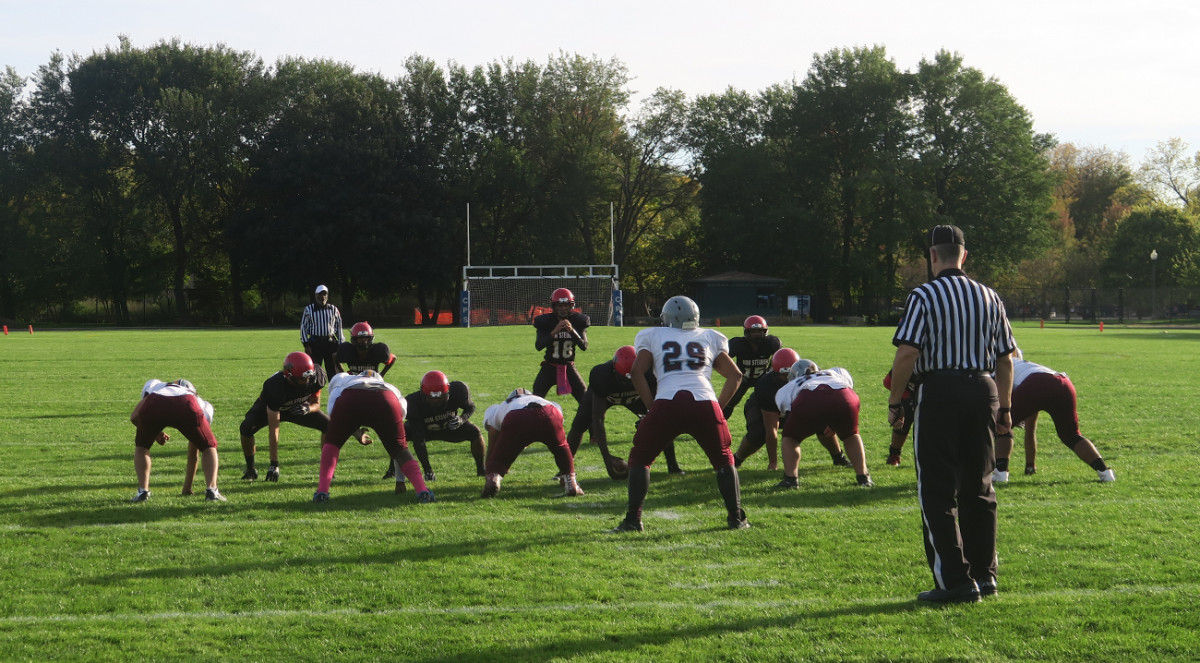
The seniors’ parents line up against the fence on the running track, holding red roses and handmade signs decorated with red and black paint and photos of their sons in Panthers uniforms. As the P.A. announcer calls out the name of each senior, along with his position and grade-point average, the crowd of maybe 100 cheers loudly. Coaches give each senior a giant bear hug after he walks through the gauntlet formed by cheerleaders.
Robles walks arm in arm with his mom, Iris Morales, to take their place in line with his 18 other classmates. Morales is a single mom, and she hasn’t missed any of her son’s games. Robles’ father is incarcerated, and has been for most of Chris’s life. “My father hasn’t really been there for me, and Coach Rood has kind of taken that mantle,” Robles says. “That male role model was never really there for me until Coach Rood took me under his wing. He taught me the ropes, and that gap in my heart kind of filled.”
“I am out of words for that,” his mother says, fighting back tears. “[Rood] has been great. He’s dedicated to the team, and I know that this requires a lot of commitment, and he showed them that.”
The 16 programs that either canceled or co-opted their teams represent nearly 20 percent of Chicago’s high school football teams, a drastic increase from the average of three a year that forfeit their seasons, according to CPS regional athletic director and football coordinator Jaton Jackson. As an alternative to 11-man tackle, Jackson quickly put together a pilot flag football league in September for the teams that dropped tackle. But by the eve of the first scheduled flag game, all of the schools had pulled out of the league, unable to field enough students even to participate in the 7-on-7 game. Jackson says he plans to explore 8-man football and combining struggling programs as possible solutions for next season.
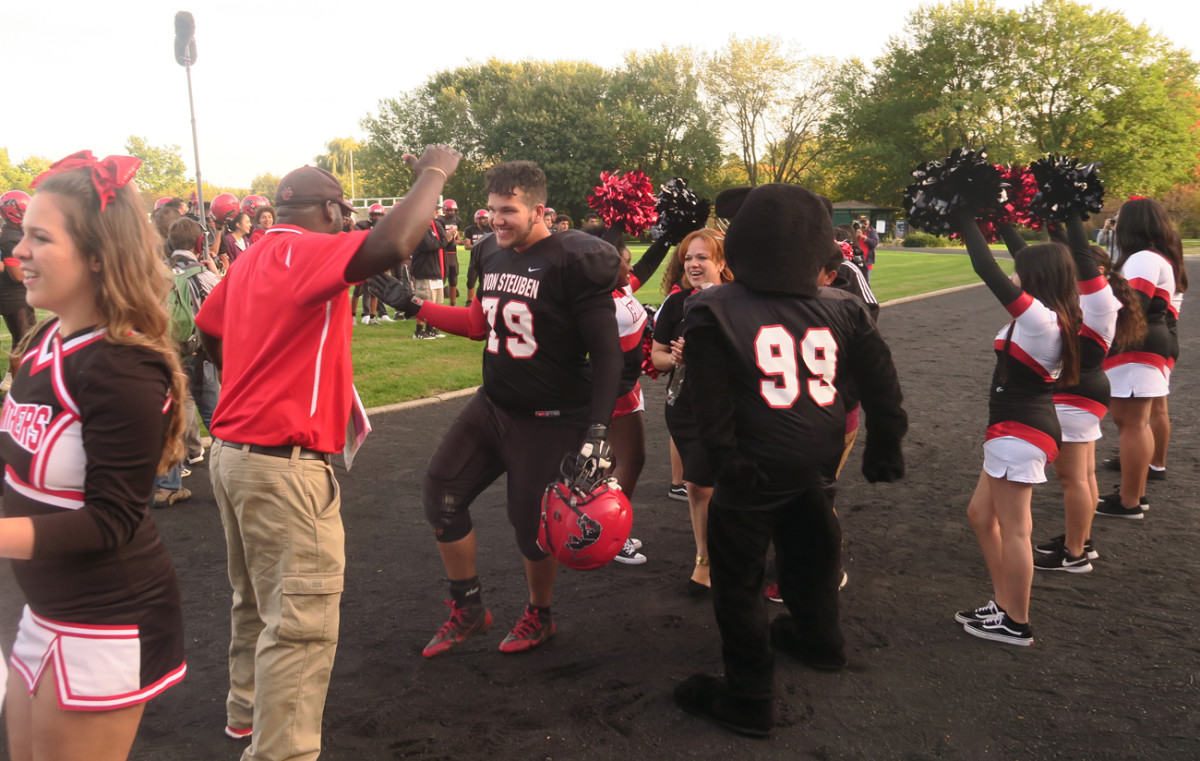
Their senior duly celebrated, Von Steuben coasts through the second half and wins easily, 29-6, finishing the season 6-3. Because they play in the bottom tier of CPS conferences, they aren’t yet eligible for the state playoffs. For now, Ortiz will take pride in what he and his teammates have accomplished in three short years. “Even if we weren’t going to finish this season 6-3, if we were going to finish 4-5, I still feel like we’d be winners, just because of what we created at this school,” he says.
Robles leads the post-victory “Panther Strong Like” chant, standing out in front of his fellow players as they crouch low to the ground in a call-and-response routine. Robles is a kid who was set free by football, and has soaked up every moment of his three years playing the game. He gets a pit in his stomach thinking about how close he came to never getting the chance. “To know that other schools are losing programs, it’s kind of scary knowing that this huge part of my life could have been gone and nonexistent,” Robles says. “I don’t know what I would do without football, honestly. I know other schools are losing it, I just can’t imagine what they might be going through.”
Beer Down, Chicago Beers
Friday, 6:30 p.m.
Lincoln Park Turf Field
“Can I get a beer for this huddle?”
It’s halftime of a co-ed 7-on-7 game pitting the Drunken Bears against the Sell-Side Stiff Arms, two teams in Chicago Sport Social Club’s flag football league. There’s no water cooler on the sideline, just a few cases of Bud Light. A few Sell-Side women drink white wine out of red solo cups.
Players crack open new cans and quickly discuss second-half strategy before the two referees hurry them back onto the turf field, just off Lake Shore Drive, with Chicago’s iconic skyline looming to the south. The 2-0 Stiff Arms, a group of young professionals, lead the 2-0 Drunken Bears, who self-identify as “Old Timers,” 24-6.
The Stiff Arms are mostly co-workers at the investment bank Lincoln International. They specialize in sell-side mergers and acquisitions, hence the team name. Captain Justin Barnes and his girlfriend, Caroline Curry, are the most experienced veterans, with five years under their belt.
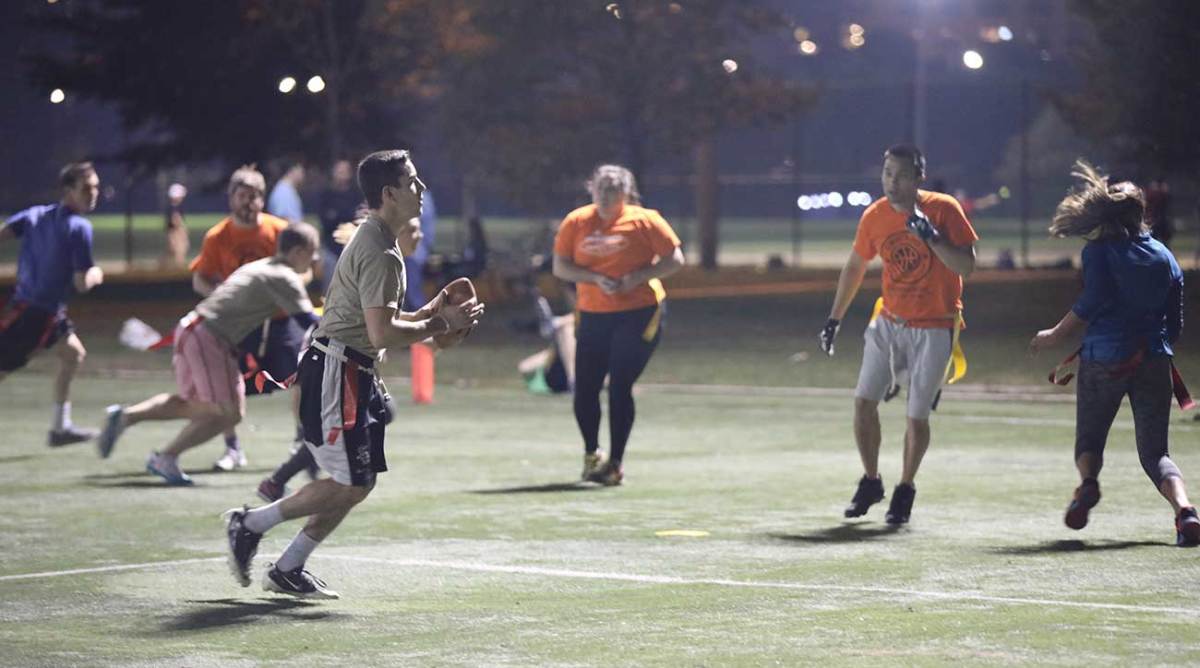
Barnes wears cleats and gloves, and he’s somewhat serious about winning. “Not to toot our own horn, but we are the two-time defending champs,” he says. “We have plays that we send out each week, just to go through the route tree and numbers.”
While the Drunken Bears are mostly dressed in their team color, orange, the Stiff Arms don’t seem to have any kind of uniform. “When we show up, we don’t necessarily look like a team,” Curry says. “We don’t even wear our shirts, sometimes we’re not matching. That’s kind of worked in our favor. We’d rather people think we aren’t going to be that good, and then we surprise them.”
The Drunken Bears, as the name suggests, are a little more lighthearted. They started playing about 15 years ago as a bunch of friends from the Chicago suburbs who attended the University of Iowa together and enjoy the Chicago Bears and drinking beer. They’ve played every year since the players were in their early 20s. “Now we’re the oldest team in the league by far,” says Dan Dusell, an original Bears player.
The Bears play more relaxed than the Stiff Arms. They never huddle. Their main play is Get Open. “We do not have plays,” Bears player Jeff Mielke says. “We make fun of the teams that do have plays.”
The Bears have been playing for so long, they have game memories that have aged into embellished legends now woven into Drunken Bears lore. “The Colleen Catch,” Dusell says reverently. Three nearby teammates all nod in agreement at the familiar phrase. “It was in a playoff game, and it was the last second. Kind of an ice bowl—it was freezing outside—and it was somewhat of a Hail Mary kind of pass in the end zone, and she just threw up her hands and came down with it to win the game. That was eight years ago and we still talk about it.”
“I think she had her coat on, like a long winter coat, and she usually is not the one that catches the ball,” team captain Sirintip Mielke adds. “We talk about it all the time.”
But Colleen isn’t here tonight to help deliver the Bears, and the Stiff Arms roll to an easy 40-6 win. Curry bats down a Bears pass at the goal line to prevent them from scoring a second touchdown late in the game.
Flag football is the fifth most popular sport offered by Chicago Sport Social Club, with more than 5,000 players registered per year. There’s a men’s 7-on-7 game playing on the field next to the co-ed game, and the refs run a tight schedule to make sure they squeeze in all the games before the field lights shut off at 11.
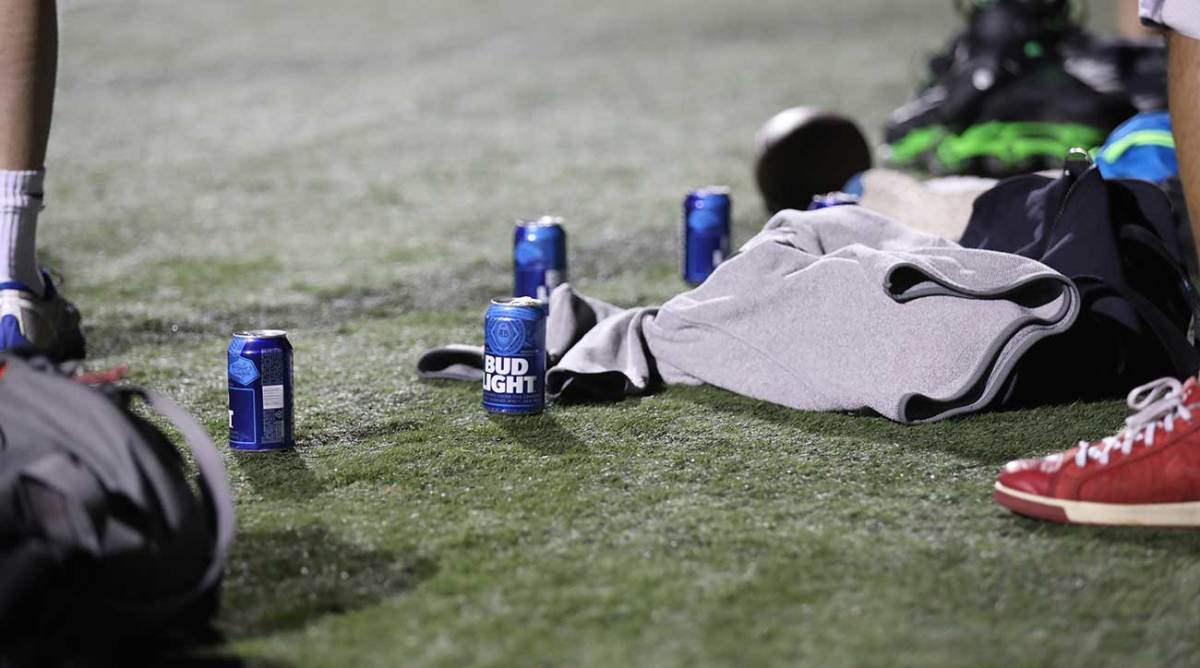
Postgame, the Drunken Bears change out of their cleats and head off to their regular bar, Ranalli’s in Lincoln Park. Usually the Bears will reward the MVP of the night with a special trophy: a can of Natty Ice. Nobody really deserved the MVP can tonight, so by default it goes to the player who scored the team’s only touchdown. “Please don’t write anything like, what they lack in talent, they make up for in spirit,” a Bears player jokes before heading off the field.
Stiff Arms captain Barnes’ stat line: one receiving touchdown, two-and-a-half beers consumed. He and his teammates have one more game to play tonight. Then they’ll go to Corcoran’s, a bar a couple blocks away, to celebrate with some black and blues: Guiness mixed with Blue Moon.
Football Finds Its Balance
Saturday, 11 a.m.
Hyde Park, South Side
The walls of the Jay Berwanger conference room are lined with cabinets displaying century-old game balls, so round they look more like basketballs when compared with today’s football. Chicago 44, Illinois 0, Nov. 18, 1907 sits above Chicago 18, Iowa 18, Oct. 22, 1894.
Just down the hallway, in the rotunda of the Ratner Athletic Center, the first-ever Heisman Trophy, awarded to University of Chicago halfback Jay Berwanger in 1935, sits in a glass case. In the early days of college football, Chicago was a powerhouse. The original Monsters of the Midway were founding members of the Big Ten conference. The Maroons played in a 50,000-seat stadium and were coached by Amos Alonzo Stagg, a legendary football pioneer who led the team to seven Big Ten titles and claimed two national titles.
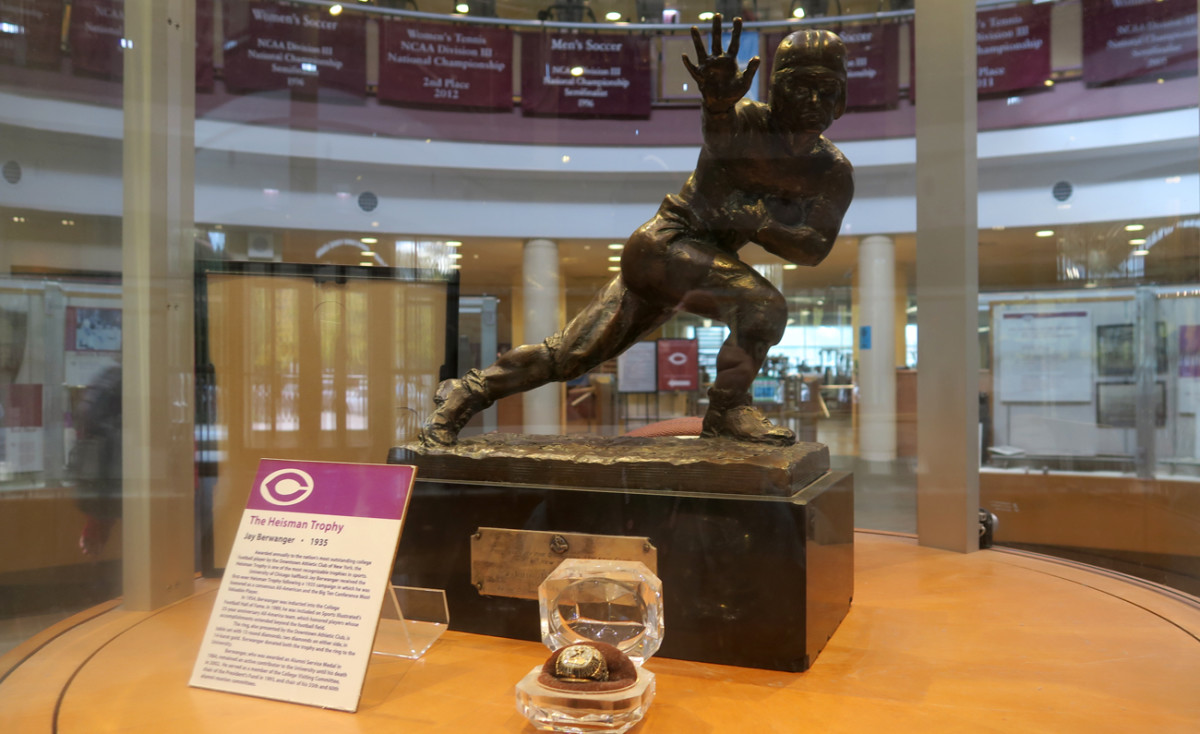
A run of four disastrous seasons from 1936 to ’39 (Chicago lost its final three Big Ten games by a combined 192-0) helped university president Robert Maynard Hutchins earn the trustee support necessary to eliminate the football program entirely. Hutchins questioned how a serious academic institution could balance its mission with a successful athletic program, and criticized schools that received more headlines for their football teams than for their academics. He wrote in the Saturday Evening Post, “In many colleges, it is possible for a boy to win 12 letters without learning how to write one.” He also referred to college football as an “infernal nuisance” in a 1954 essay for Sports Illustrated, asserting, “Football has no place in the kind of institution Chicago aspires to be.”
The Maroons program lay dormant for 30 years before crawling back to life in Division III in 1969. At that level, Chicago is freed of many of the issues that concerned Hutchins, and that plague top-tier programs to this day. “D-III is a great philosophical fit for our institution,” says coach Chris Wilkerson, who came to Chicago in 2013 after eight years at Dartmouth. “When Coach Stagg was here, there weren’t a lot of rules and regulations, and I think our administration didn’t like what they saw as the future of big-time college football. Sometimes if you look at the state of today’s game, you may think they were actually ahead of the curve.”
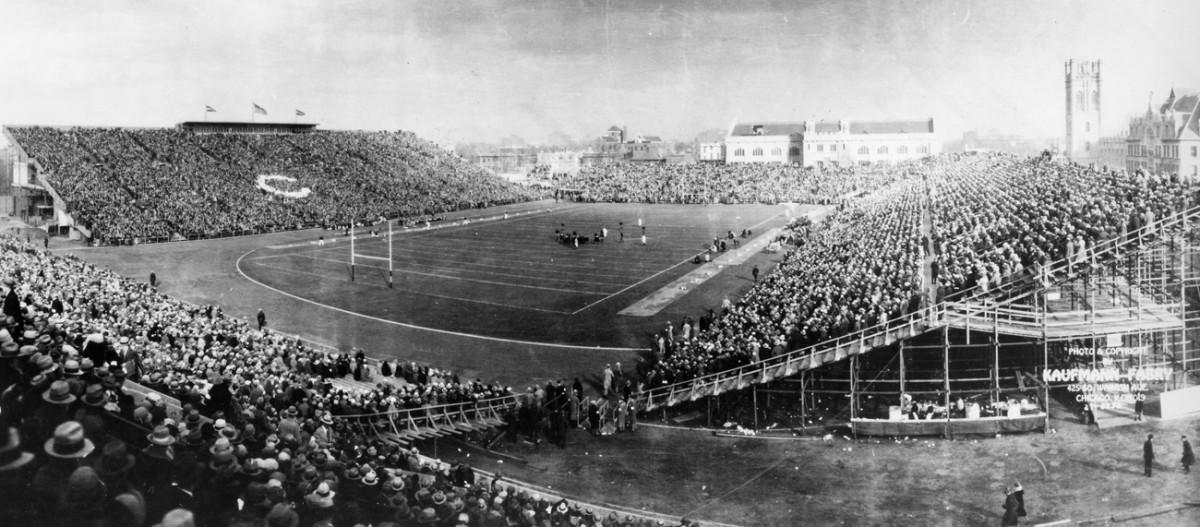
Wilkerson is well-versed in Maroons history, and he smoothly delivers a quote from Stagg: “‘Winning isn’t worthwhile unless one has something finer and nobler behind it,’” he says. “And I think Stagg would be pretty happy with where we are today. As wild as it was back then, I think he still believed in the holistic approach.”
By holistic, Wilkerson means finding balance, a program where the focus is on football and academics in equal measure. Junior defensive end Jeremy Vincent turned down several offers to play D-I ball, choosing Chicago over a chance to play at big PAC-12 programs Washington and USC. “The decision of where to go to college isn’t just a four-year decision, it’s a 40-year decision,” says Vincent, a Maroons captain. “I knew I was going to be able to play football wherever I went, so it was more about, what can I get besides football?”
Senior running back and captain Chandler Carroll, Chicago’s second all-time leading rusher, already has a job lined up at J.P. Morgan after graduation. “Being able to go to school, come to football, and then go to career info sessions, or meeting with companies, that’s what separates UChicago from the rest,” Carroll says. “A day in the life: You wake up early if you have lifting, go to class, come out for football, then you quick change into a suit and tie go to an interview after practice.”
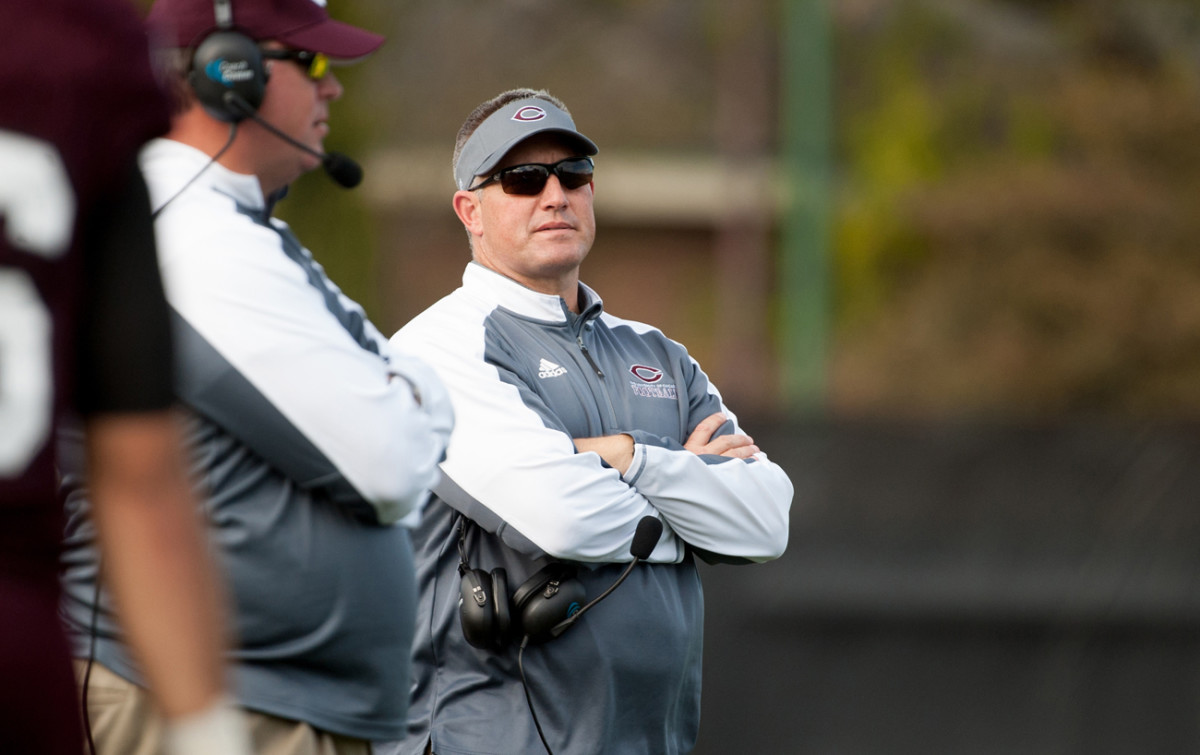
The players are surrounded by reminders of the team’s rich history. The mantra they chose this season, Tradition Continues, is written in gothic script on maroon rubber bracelets that players and coaches wear every day. At the year-end banquet, first-time letter-winners sign their names into a large leather-bound volume that recognizes every varsity athlete in the school’s history.
“Every day we walk in the facilities and we have the Heisman Trophy looking at us and all these game balls and the Big Ten championship banner,” Vincent says. “They had that great success back in the day, and we want to make sure that we keep that going. That doesn’t die no matter what conference or whatever team you play.”
There’s a well-known stereotype about the school’s rigorous academic reputation: Where fun comes to die. But today is homecoming, and the scene is lively. On 56th Street next to the athletic fields the school has set up a block party with cheap food, free beerand plenty of UChicago swag. A couple hours before kickoff, the street is packed with alumni and fans, young and old.
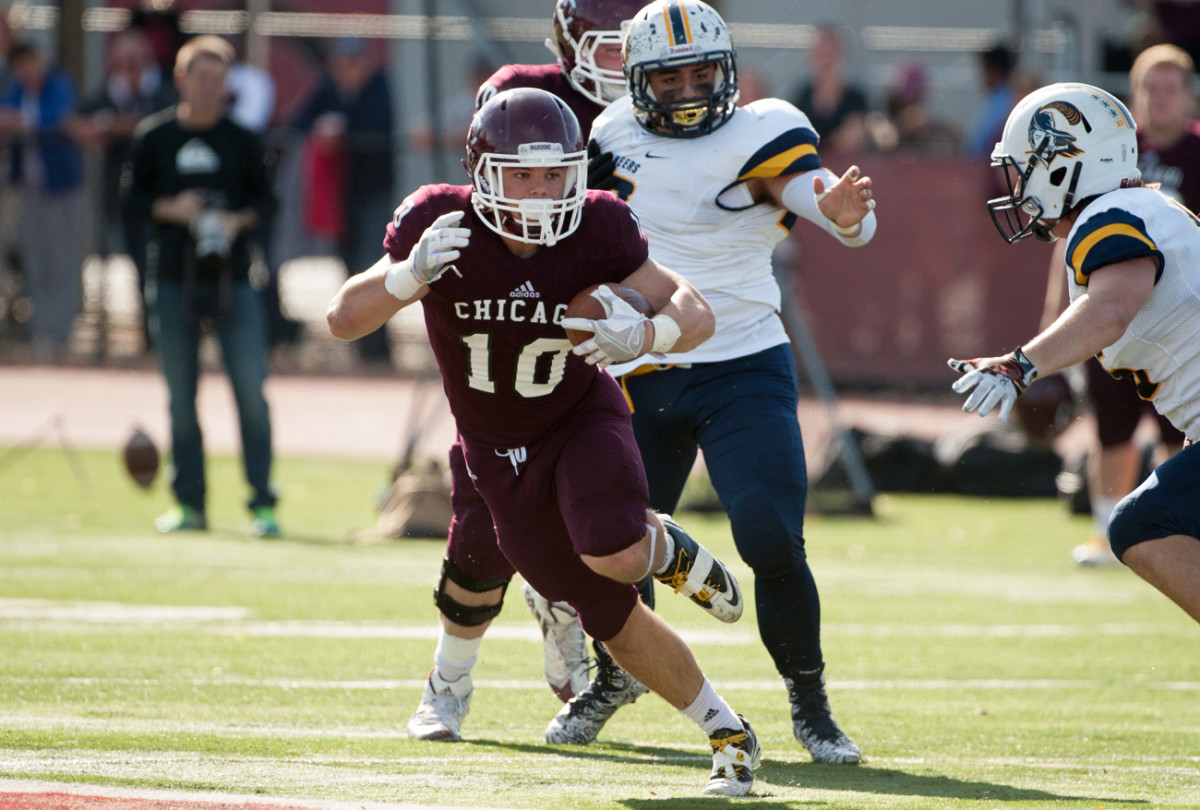
Two middle-aged former Maroons football players gather around a grill near the entrance to Stagg Field. Mike Conway and Mike Kiechenheiter both played linebacker in the mid ’70s, the early days of the team’s revival, when hardly anyone showed up to games and most of the general public had no idea that football had returned to campus. The pair have been coming back to games for the last decade now, and are stunned by the rise in fan support. “Ten years ago it would be us, a couple other guys and a couple six packs. It was empty,” says Conway, Class of ‘77.
Kirchenheiter (’78) points towards the field where the Maroons are warming up. “Look at that team out there,” he says. “There’s 90 kids in uniform. There were 38 of us.”
Today’s homecoming opponent is winless Beloit College in the Midwest Conference, which the Chicago football program joined as an associate member this season. The 3-3 Maroons build a quick lead, with Carroll his taking his first carry 28 yards, and scoring on a 12-yard run to end the first drive. “Chelsea Dagger” booms over the P.A. system after each Maroons score and cheerleaders perform in front of the crowd of nearly 1500. Beloit can’t contain Chicago’s run game, and the Maroons rack up 433 rushing yards, averaging 8.8 per carry. Carroll takes much of the early work, adding two more scores in the first half and finishing with 12 carries for 123 yards. The defense holds Beloit scoreless until the Maroons backups take the field midway through the third quarter.
Even with a comfortable late in the game, it’s the Maroons’ final touchdown that means the most to the players. Senior running back Floyd Pitts III carries 10 yards into the end zone for his first collegiate score, sealing Chicago’s win 55-12. Pitts runs to the sideline and is met first by Carroll, his roommate, as the entire team piles on. As a freshman in training camp, Pitts broke his leg in two places. The injury was so severe that he missed his entire freshman, sophomore and junior seasons rehabbing.
“That touchdown was my favorite moment in my career, honestly,” says Carroll. “That was really cool for me to see him score his first collegiate touchdown after all the hard work he has put in. It was a pretty horrific injury. He’s been struggling to come off that, and this year he has finally been fully healthy. ”
After the game the players run off the field into the small locker room.
“We chose to come to the University of Chicago!” Wilkerson shouts inside the cramped space, voice hoarse from yelling during the game. The players shush each other in anticipation and look to Wilkerson, standing in the middle of the huddle. Someone shouts, “Tell ’em coach!” They all know what comes next. Wilkerson pauses for a few seconds, then yells, “It ain’t where fun comes to die—”
“NO!” the players shout back.
“—it’s where excellence comes to thrive!”
The players erupt in cheers, jumping up and down, banging their helmets on the metal air ducts overhead.
“He does that after every win,” Carroll says. “We kind of turn the mantra on its ear.”
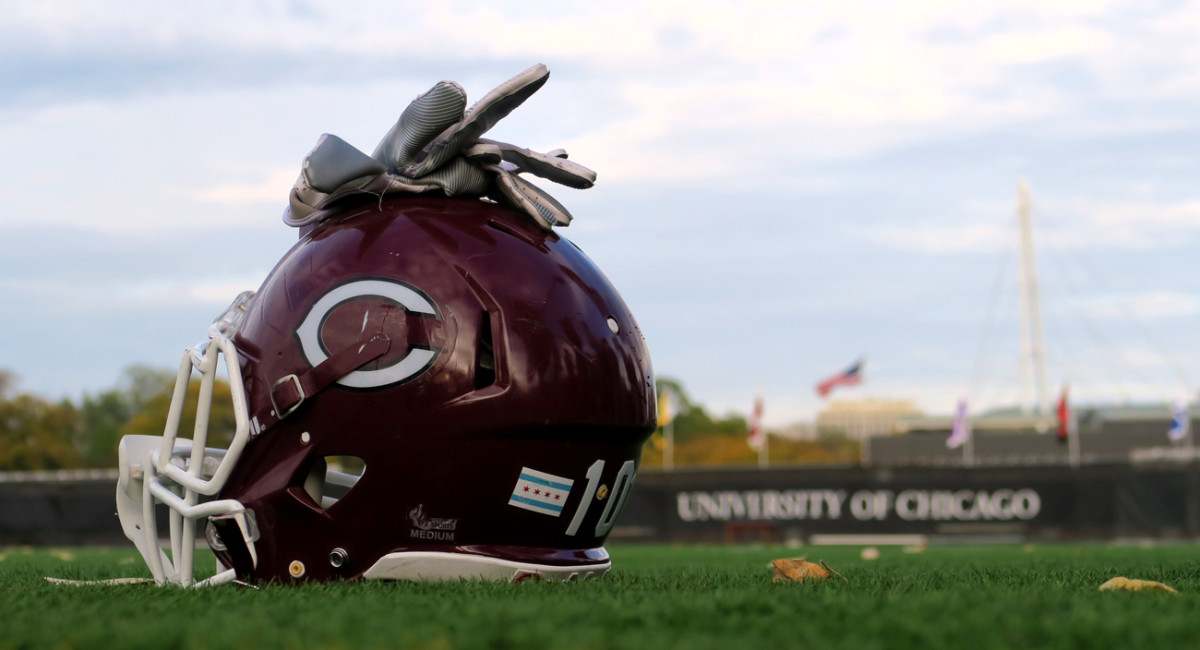
Where the Past is Always Present
Sunday, 10 a.m.
Soldier Field, Lakefront
Spend just a few minutes tailgating in the parking lots outside of Soldier Field and you’ll notice a central theme: Bears fans are stubbornly, painfully stuck in the past. Spotted in the line to use the porta-potties on the Upper Waldron parking deck just south of the stadium: PAYTON 34, BUTKUS 51, DITKA 89, URLACHER 54, SINGLETARY 50, DENT 95, SAYERS 40. Roaming through the crowd, you’ll notice that PERRY 72 is here, as is FENCIK 45 and all the way back to HALAS 7. Even, wistfully, PICCOLO 41. Small children run around playing catch in No. 34 Sweetness jerseys, though they were born decades after Walter Payton last carried the ball.
Brian Highland of suburban Orland Park is wearing Mike Ditka. Highland was born in 1982, meaning he wasn’t alive to see Ditka as a Bears tight end and was just three years old in 1985 when da Coach took Chicago to its lone Super Bowl title. What does he recall of that fabled season? “I just remember my dad screaming at the TV.”
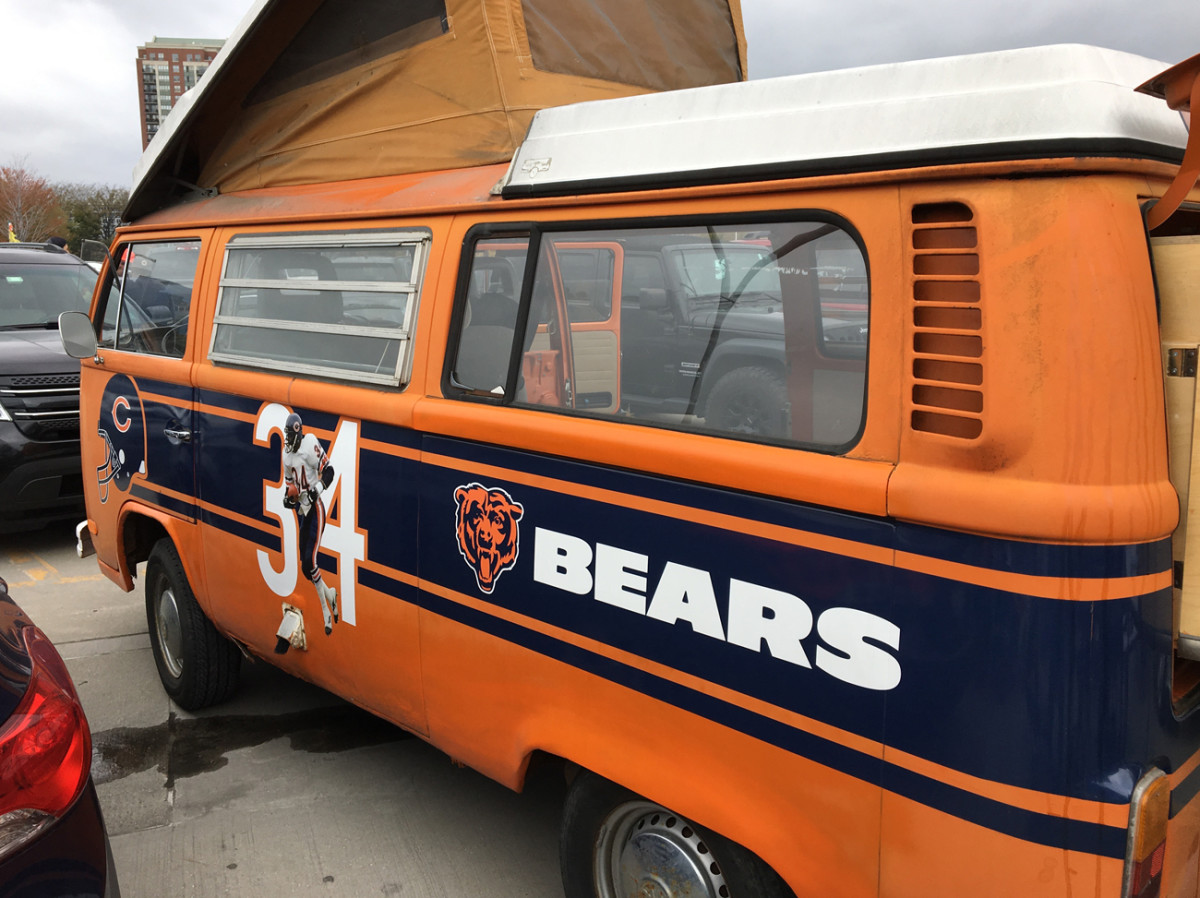
As for a more current jersey, Highland isn’t even remotely interested. When asked what it would take to get him to replace his Ditka shirt, he hesitates. “I honestly don’t know. It would take a lot.”
With the Bears coming off back-to-back 3-13 seasons, it’s easy to see why fans prefer to recall players they trust and admire. “I’m not even wearing a jersey until they put a winning season together,” says season-ticket holder David Spire, sporting a dark blue Bears logo tee shirt. “It’s tough. Three-and-13 will get you a little skittish.”
Spire is the lone member of his tailgating group not wearing the jersey of a Bears Hall of Famer. His pals Chris Burke and Joe Racine sport Butkus’s 51 and Dan Hampton’s 99, respectively. “The jury is still out on this team,” says Burke, of Naperville. “I think we wear these old jerseys because we’re dreaming about these type of players. We need more players like this.”
A few tailgates down the row, Crystal Finch is decked out in a bedazzled No. 95 Richard Dent shirt, jeans embroidered with the Bears logo, and a pair of handmade blue-and-orange rhinestone encrusted heels. “I’m wearing a Dent jersey because this franchise is all about the D, baby!” she says.
Like Highland, she’s not ready to take the plunge on No. 22 Jordan Howard or No. 29 Tarik Cohen just yet. “I'm done buying jerseys of people that come and go,” she says. “I bought [Brandon] Marshall, [Alshon] Jeffery, and when he left, that was it. We'd have to hit the playoffs first and then I’m open to the suggestion.”
Finding the jersey of a current Bears player is like trying to spot a bald eagle in the Loop. This writer tallied just four TRUBISKY 10 jerseys amongst the sea of Butkuses, Paytons and Urlachers during a 45-minute walk through the Upper Waldron tailgate scene. A fan named Pete has a Trubisky shirt underneath a pair of orange-and-blue striped overalls, as if he’s not fully committed. “We do like our history here,” he says, munching on pheasant that was shot and prepared (teriyaki style) by others in his group. “But hope springs eternal. I traded in my Payton jersey for this one.”
Inside Soldier Field, an intro video plays on the big screens before the game. “The Bears are my team, your team, and together we will continue to make history,” Dick Butkus tells the crowd. As he speaks, a montage of black-and-white highlights of Bears defenses of old plays out. The franchise knows its fans.
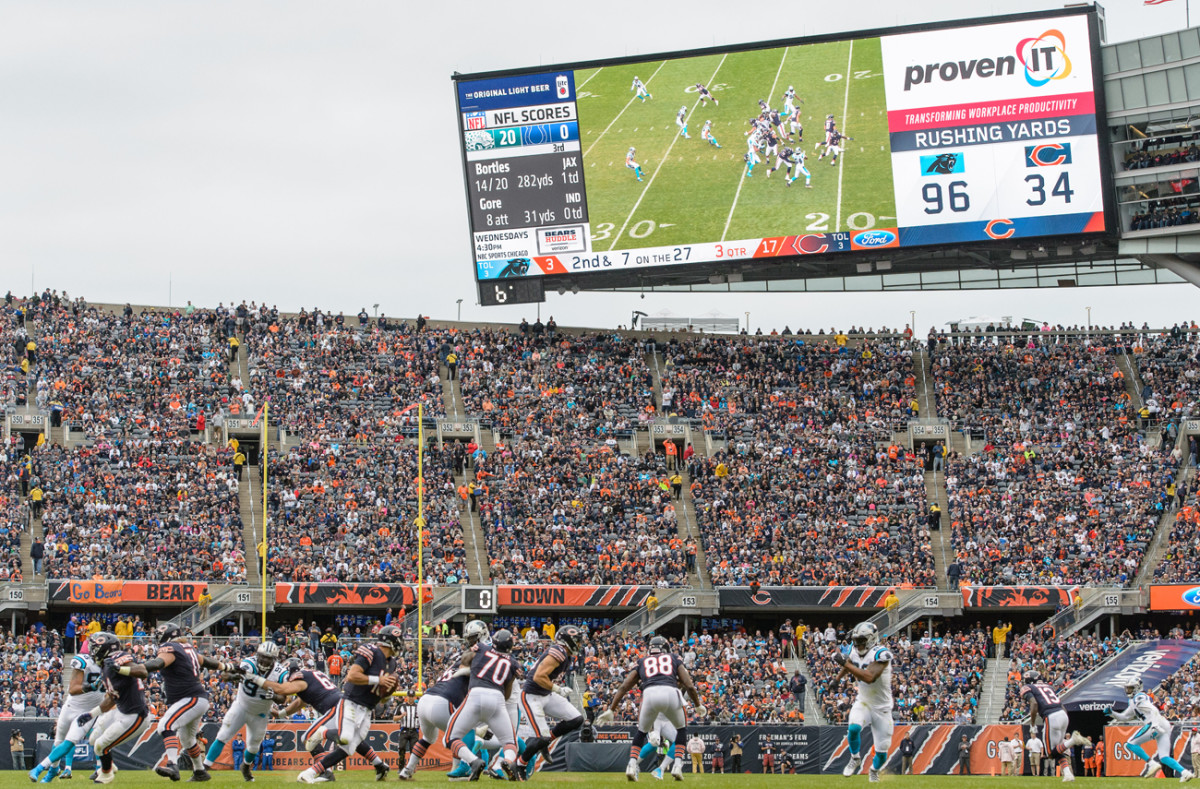
This Sunday is indeed a throwback to old Bears football—the defense dominates, while the offense struggles. Linebacker Danny Trevathan sacks Panthers quarterback Cam Newton on Carolina’s second possession, the first of five Bears sacks in the game. Rookie safety Eddie Jackson single-handedly accounts for 14 Chicago points, with a fumble return for a touchdown and pick-6. He becomes the first player in NFL history with two 75-plus yard touchdowns returns on defense, a year to the day of breaking his leg as a college senior at Alabama. Mitch Trubisky, the 2017 first-round pick making his third start at QB, attempts just seven passes, completing four. The lone offensive highlight comes on deep Trubisky throw to rookie running back Tarik Cohen, a 70-yard gain. It’s one of only three first downs the Bears make before their final possession, when they run out the clock on a 17-3 win.
In the locker room afterward, second-year Bears linebacker Leonard Floyd rushes to grab a copy of the game book for a big-picture look at how well the defense performed. This was the kind of performance the fans wearing 51, 54 and 95 had been waiting for. Floyd (No. 94, for those in the market) sits down at his locker and flips through the booklet, nodding. “Chicago was always known for nasty defense, that tenacious defense,” he says. “We came out today and played like that.”
“We scored twice on defense, so that says it right there,” says defensive tackle Eddie Goldman.
The defensive players are chatty at their lockers, but not giddy over the win. They don’t seem all surprised by their unit’s shutdown of Carolina’s offense. “Looking back at camp, I saw that we had the pieces to do it, and everybody felt it,” says Goldman. “Coaches felt it, players felt it. We just gotta get it done.”
Goldman pauses for a second, and then delivers the sweet words that Chicago fans still holding on to the glories of yesteryear long to hear.
“I feel like we can bring it back. We can be the Monsters of the Midway again,” he says. “That mantra can come back to Chicago. I can promise you, we are going to try our best to make that happen.”
• SUBSCRIBE TO THE MMQB NEWSLETTER. Get “The Morning Huddle” delivered to your inbox first thing each weekday, by going here and checking The MMQB newsletter box. Start your day with the best of the NFL, from The MMQB.
• Question or comment? Email us at talkback@themmqb.com.
